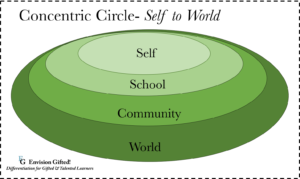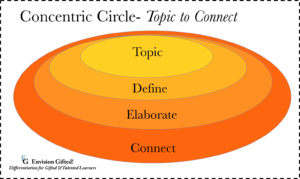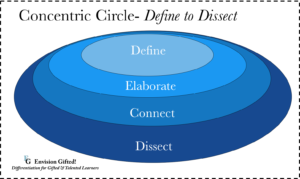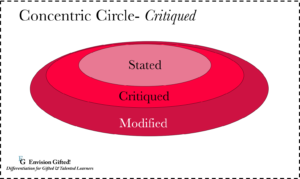When given the opportunity and the appropriate tools, the level of understanding knows no bounds.
Concentric Circles- Diffusion of Knowledge
One way to think of this model is the analogy of the ripples that radiate out from the point of impact when a rock is thrown into a lake. In Concentric Circles of Knowledge, student thinking and understanding radiates out from the point of impact of the reading, topic, lesson, etc. The purpose of this instructional model is to process connections and relationships. Of course this model can also be used in the reverse, moving from the broad outer circles to the inner circle. Check out this article from Dr. Jessica Manzone.
Download File Con.circles 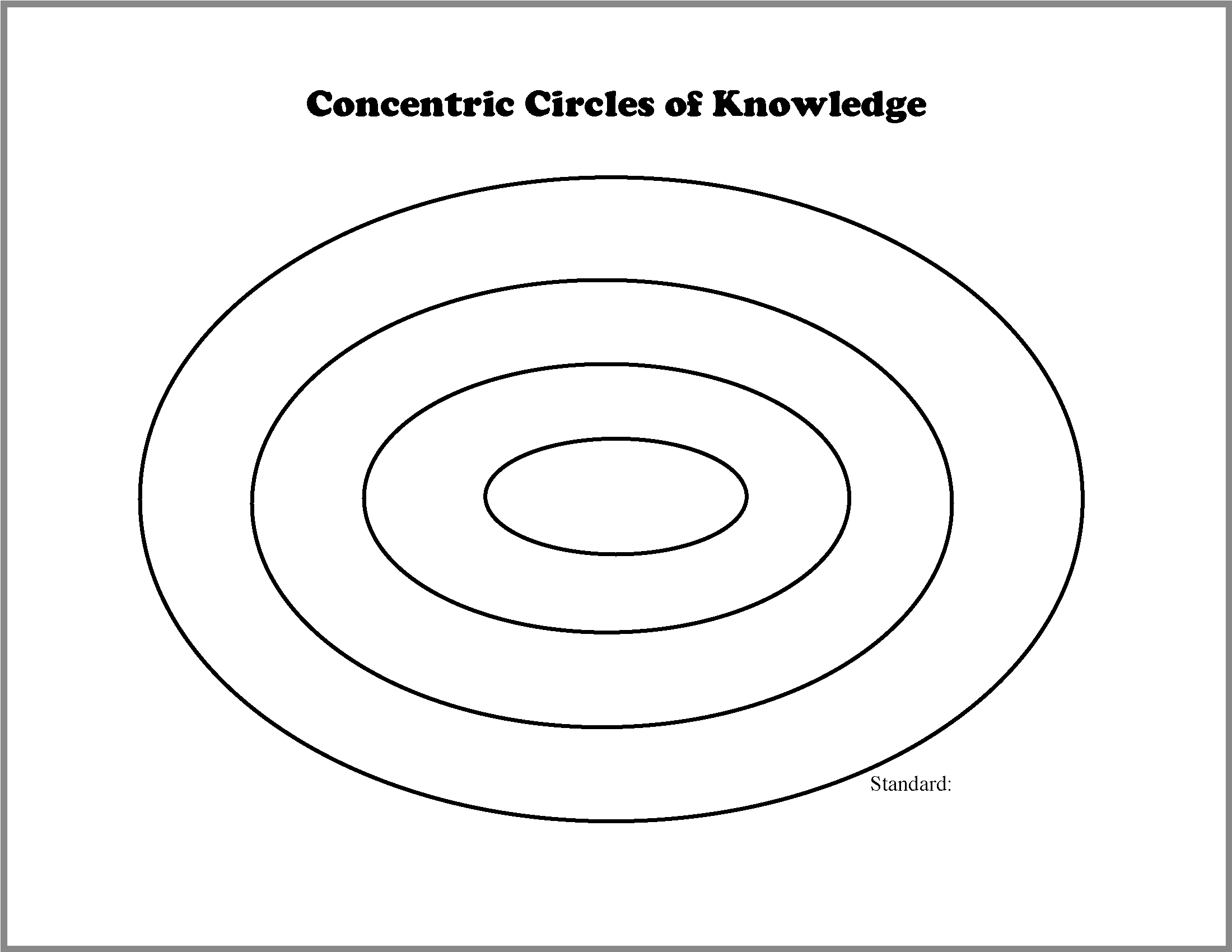
How does this model fit within differentiation, and how does it work with thinking tools?
 We differentiate through Acceleration (TLAD, Big Idea, Universal Concepts), Depth (details, patterns, etc), Complexity (multiple perspectives, change over time, etc), and Novelty (independent study, etc). The concentric circle model can be differentiated through these elements.
We differentiate through Acceleration (TLAD, Big Idea, Universal Concepts), Depth (details, patterns, etc), Complexity (multiple perspectives, change over time, etc), and Novelty (independent study, etc). The concentric circle model can be differentiated through these elements.
Starting with the core content in the middle, you can design the learning so it radiates out using only a single element or multiple elements.
This example places wildfires as the content and uses acceleration in each outer ring to differentiate the learning. In this example, we have Think like a Disciplinarian in each ring. You can see how the rings foster a connection to the content and a deeper and more broad understanding. 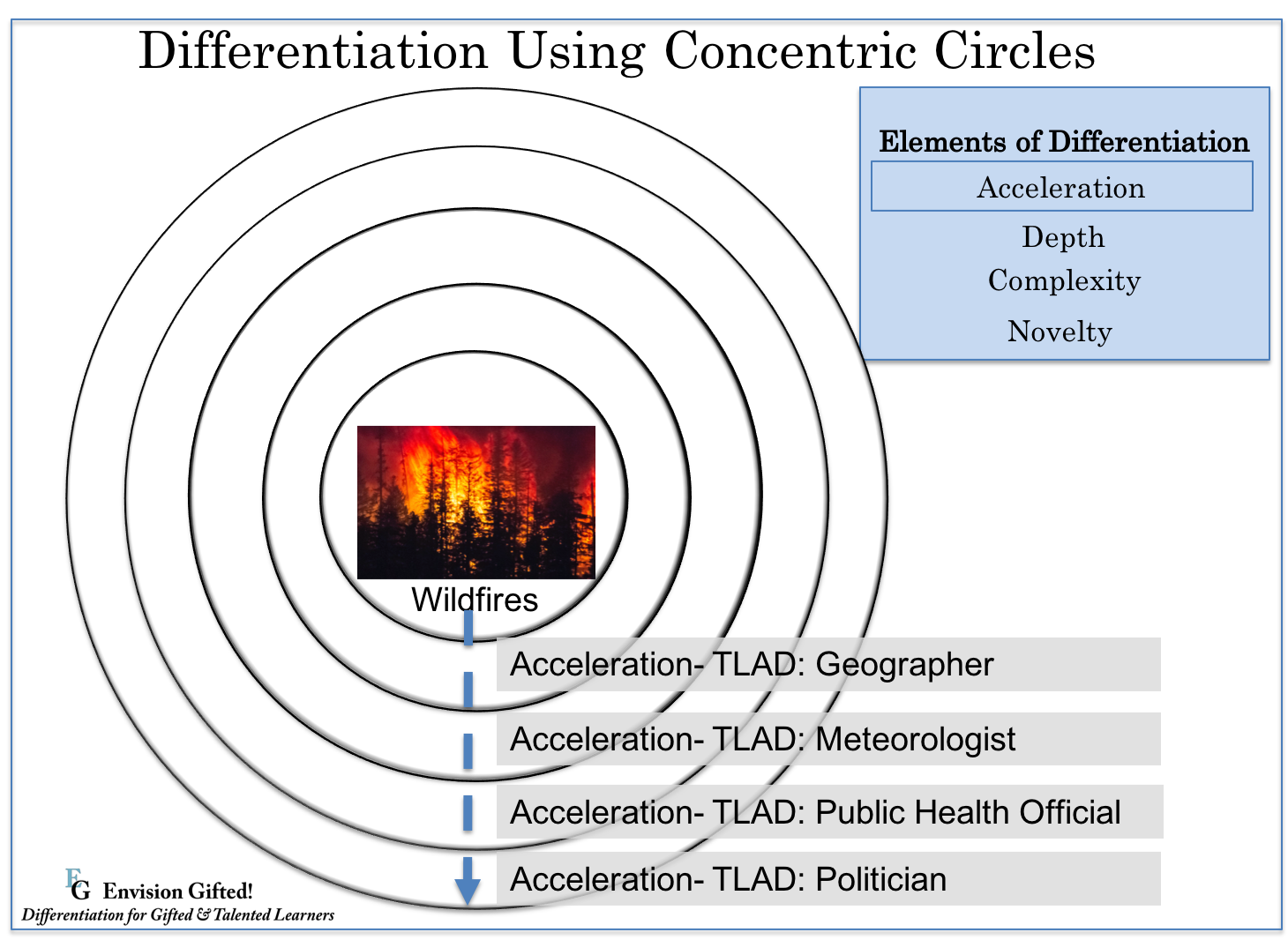 The choice of academic discipline with TLAD is dependent on what you would like to emphasize. You could substitute a big idea or universal concept in one of the rings. What might the study look like if you were to place the universal concept of Adaptation in one of the rings? How might it change if you used the universal concept of Systems? or Power? The best is when students can take ownership of their learning and you offer them choice in one or more of the rings.
The choice of academic discipline with TLAD is dependent on what you would like to emphasize. You could substitute a big idea or universal concept in one of the rings. What might the study look like if you were to place the universal concept of Adaptation in one of the rings? How might it change if you used the universal concept of Systems? or Power? The best is when students can take ownership of their learning and you offer them choice in one or more of the rings.
Different Concentric Circle Frameworks –
Consider these different concentric circle frameworks to explore connections and relationships. They are dependent on purpose of the learning and vary in cognitive demand. Self to World requiring a different level of thinking than Critiqued.
Concentric Circles for Researching the Lives of Others
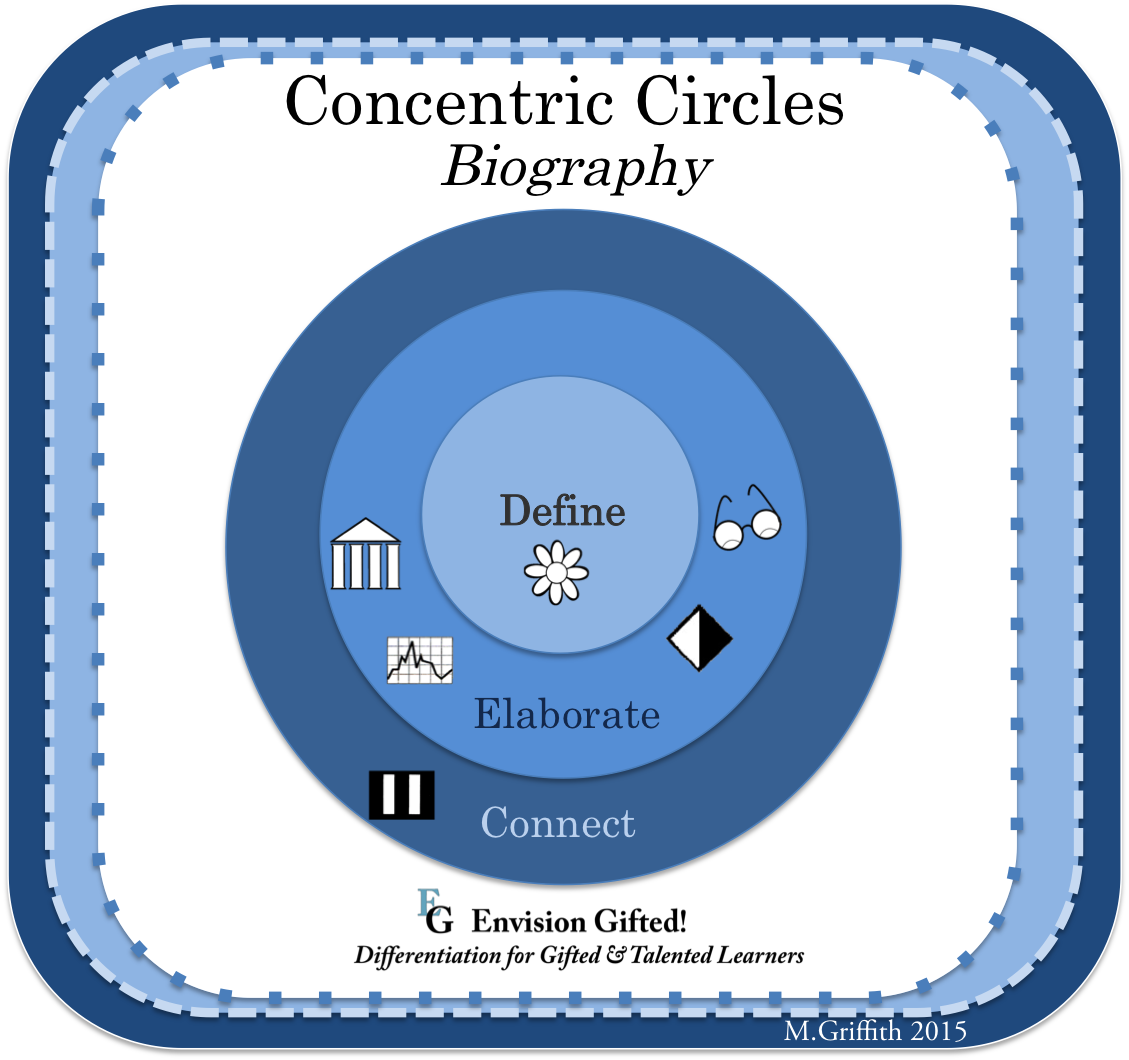
Concentric circles are great for helping students dig deeper in their research.
For example, if your students are working on biographical research you can have them use the inner most circle to define the person.
- “What are the basic details we need to know about this person?”
The next circle is dedicated to elaborating more about the person.
“Tell more about the person.
- What are some ethical issues that surrounding his/her life or work? What conflict(s) did this person encounter and overcome?
- How did other people perceive this person or his/her work?
- What is the big idea that drove this person?
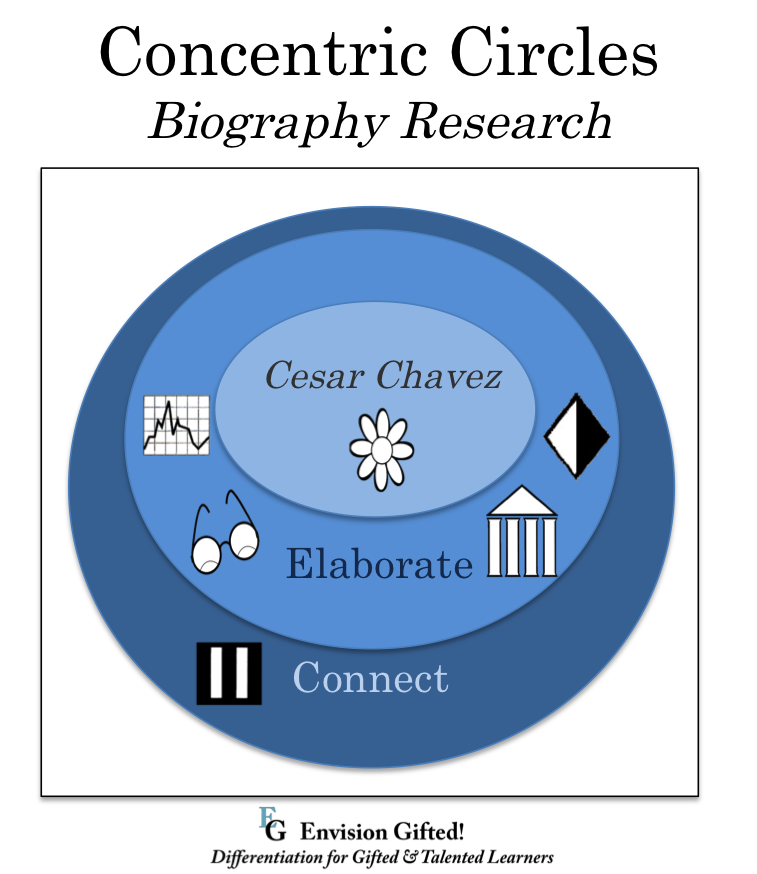 What trends contributed to the experiences (both positive and negative) of this person?
What trends contributed to the experiences (both positive and negative) of this person?
The final circle is used to draw parallels/connect this person to a larger context.
- “How does this person connect to other people during this time period; Other time periods?
- What parallels can you draw between the big idea of the person and other people who shared a similar big idea?
Where have we seen other people like this person?
Concentric Circles- Change Makers
 Tired of assigning the same old biography research assignments?
Tired of assigning the same old biography research assignments?
Why not have students focus their research on Change Makers or more specifically, young people who have changed the world? Sometimes it can be more challenging for students when they select a contemporary individual because of the varied types of research required and potential limit on available information. Despite these potential challenges, the ability to gather information from a variety of sources is not a new requirement and the experience for students is invaluable.
Concentric circles are great for helping students dig deeper in their research. Move beyond the expected or usual people in history that students often research and already know a lot about.
Beyond Malala:
Often students don’t know who they wish to learn more about so they fall back on the usual topics. Foster a sense of wonder and desire to know more. Providing students with the opportunity to browse and develop interest in different people makes all the difference. Students might browse through a book such as, Little Dreamers Visionary Women Around the World by Vashti Harrison to get inspiration. You might also check out this website Brightly- 12 Inspiring Illustrated Biographies That Introduce Kids to Diverse Heroes, for inspiration or a launching off point for students. Have a mental list of potentially intriguing individuals at the ready so you can ask students- “Are you familiar with _____?” or “I was reading about _____ and found his story fascinating. Have you heard of him?”
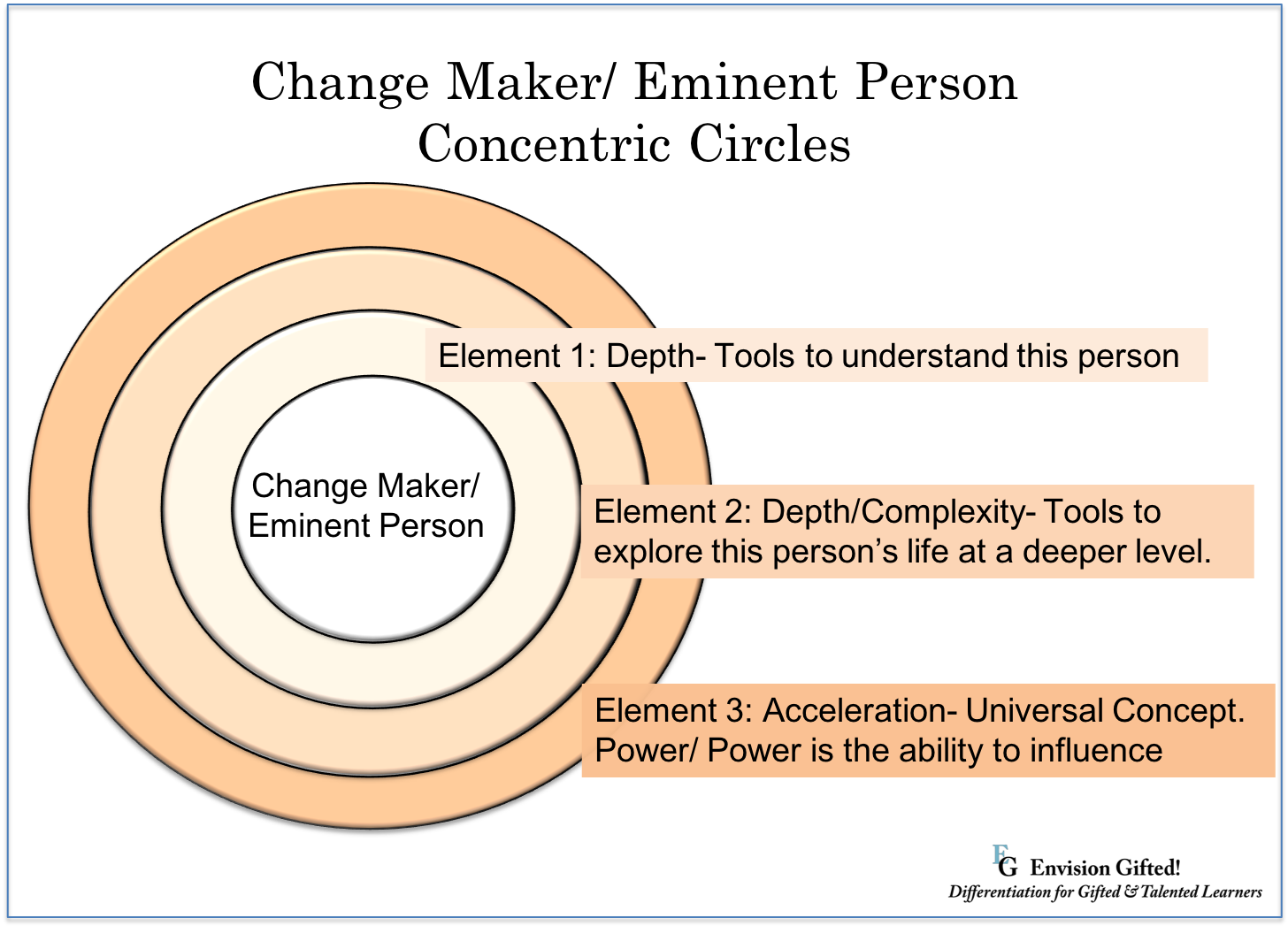 This image shows one way concentric circles might be designed for student use. Consider how students might go from a concentric circle model of learning to creating a unique and creative product that demonstrates their learning.
This image shows one way concentric circles might be designed for student use. Consider how students might go from a concentric circle model of learning to creating a unique and creative product that demonstrates their learning.
So, have you heard of Sylvia Acevedo? She has a fascinating story!
Sylvia Acevedo- Resources: Website, NPR (National Public Radio) , Autobiography – A Path to the Stars: My Journey from Girl Scout to Rocket Scientist
Non-Fiction Resource!
Check out the great site 12 Story Library (link right).  It’s a free resource that goes along with their books, however, you don’t need their books to benefit. The book topics are constantly updated and allow students to continue research into their topic with recent and relevant information.
It’s a free resource that goes along with their books, however, you don’t need their books to benefit. The book topics are constantly updated and allow students to continue research into their topic with recent and relevant information.
Go to- Concentric Circles in Literature
Save

